Introduction
Robotic Process Automation (RPA) is revolutionizing business operations by automating repetitive tasks and streamlining processes. By deploying software robots, or ‘bots’, RPA simplifies complex business tasks through automation. These digital assistants can perform a wide range of activities, from data entry to manipulation, by emulating human interactions with various applications and systems.
RPA’s impact is exemplified by a large consumer packaged goods company that used RPA to process a massive amount of unstructured data from thousands of suppliers, enhancing their procurement strategy. The integration of RPA into enterprise operations starts with small tasks and gradually scales up, ensuring continuous monitoring and documentation of results. RPA enhances operational efficiency by handling routine tasks, allowing human creativity to flourish and fostering collaboration between humans and digital labor.
As industries continue to navigate digital transformation, RPA, empowered by AI, offers practical solutions to enhance business automation.
What is Robotic Process Automation (RPA)?
Robotic Process Automation (RPA) stands at the forefront of enterprise modernization, offering a transformative approach to streamlining repetitive, rule-based tasks. By using software robots, or ‘bots’, RPA streamlines the complexities of organizational procedures through mechanization. These digital assistants are capable of performing a myriad of tasks such as data entry, extraction, and manipulation by emulating human interactions with diverse applications and systems.
A notable example of RPA’s impact is seen within a large consumer packaged goods company, which faced the herculean task of processing purchasing documents from over 50,000 suppliers across nearly 200 countries. The implementation of RPA, complemented by AI, enabled the company to convert a staggering amount of unstructured data into actionable insights, thus enhancing their procurement strategy.
The integration of RPA into enterprise operations often begins with small, manageable tasks, gradually scaling up to more complex workflows. This stratagem ensures continuous monitoring and documentation of results, paving the way for informed decisions and strategic advancements. Recent advancements, as exemplified by the Korea Institute of Machinery and Materials, reveal that AI-powered robots have the ability to understand user instructions and independently carry out actions, highlighting the potential for RPA to transform manufacturing operations.
In the domain of automating workflows, achieving a harmony between human knowledge and robotic effectiveness is crucial. RPA augments the workforce by handling routine tasks, allowing human creativity and critical thinking to flourish. The synergy between human and digital labor not only elevates operational efficiency but also fosters a collaborative ecosystem where each entity enhances the other’s strengths.
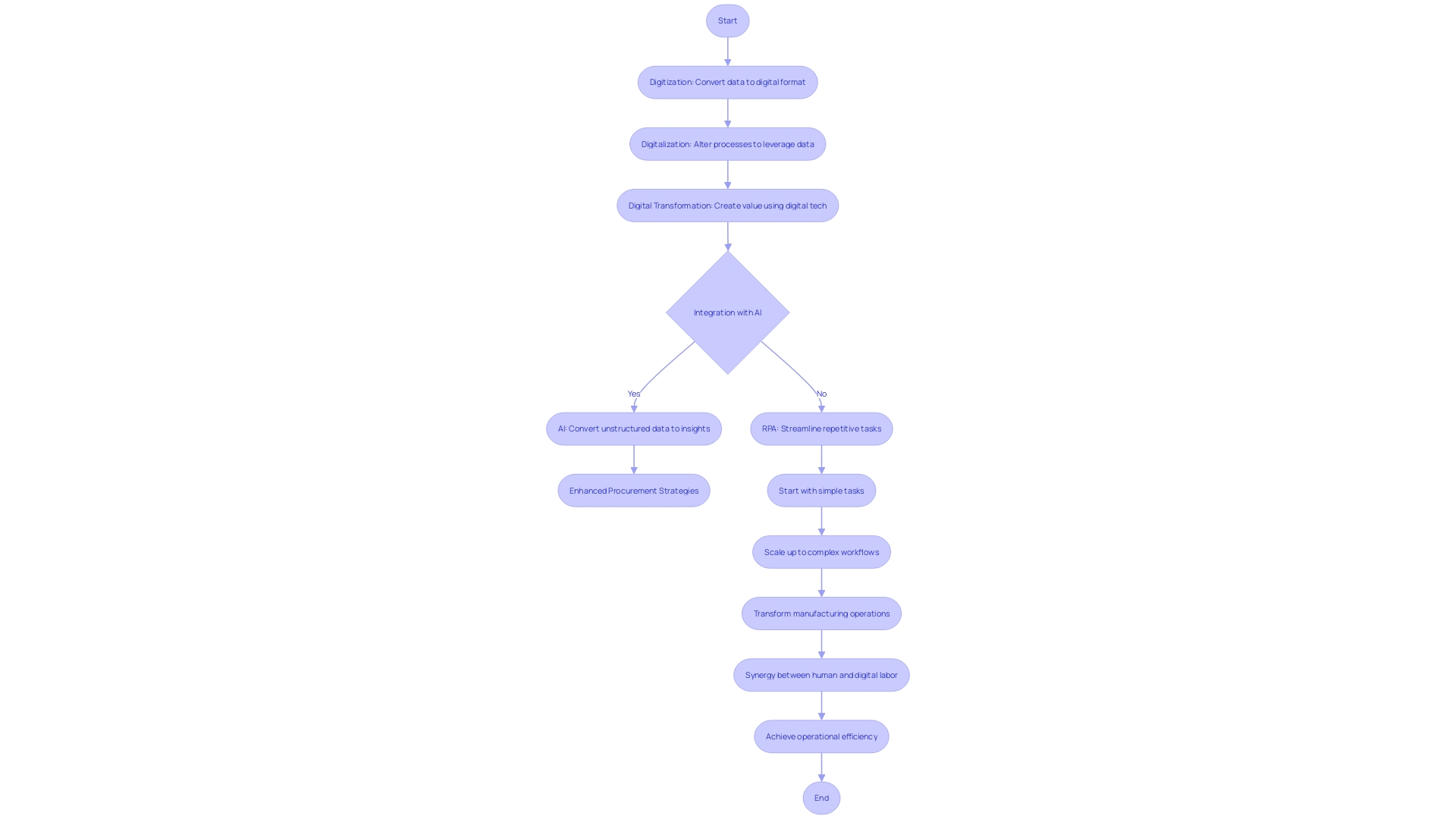
Key Characteristics of RPA
Robotic Process Automation (RPA) is a critical asset for modern organizations, providing seamless integration with existing software applications and systems. It’s a non-invasive technology that enhances business procedures without the need for altering current infrastructure, which is particularly beneficial in settings like the NHS where technologies must be compliant and secure. RPA’s scalability allows organizations, like Specsavers with its complex supply chain and legacy equipment, to automate a wide range of activities, both simple and intricate.
The rule-based nature of RPA ensures that tasks are performed with precision and consistency, addressing inefficiencies in manual operations. This was echoed by the Digital Service Team’s initiative to assess and streamline technology requests within the NHS, ensuring that only necessary and non-duplicative technologies are adopted. The easily adjustable aspect of RPA aligns with the continuous enhancement and digital assurance procedures that organizations are increasingly embracing to fulfill evolving enterprise requirements and regulatory standards.
By leveraging intelligent integration of RPA and AI, organizations can not only streamline repetitive tasks but also acquire valuable insights to enhance decision-making. This was emphasized in the evolution of business methods at Coding Crafts, where they stress the significance of innovation and staying ahead of the curve in technology advancements. The integration of RPA in various industries is reinforced by statistics indicating the significant impact of automation on productivity and the expansive reach of electronic health records management systems like Epic EHR and Cerner.
Furthermore, RPA’s role in hyperautomation is crucial as it serves as a basis for ongoing optimization, contributing to a strategic necessity for the future of work. By adopting RPA, organizations can ensure their workforce is empowered, procedures are optimized, and they are well-prepared to harness the full potential of AI.
How RPA Works
Robotic Process Automation (RPA) leverages software robots or ‘bots’ to automate routine and manual tasks that typically require human intervention. These tasks range from data entry and retrieval to complex calculations and report generation. RPA bots are adept at navigating through various systems and applications, utilizing APIs and connectors to streamline data handling. They’re also capable of interfacing with advanced technologies such as Artificial Intelligence (AI) and Machine Learning (ML), augmenting their functionality to tackle more nuanced tasks.
The integration of RPA can transform how small businesses engage with customers, enhancing satisfaction through quicker responses and consistent, accurate information. By automating these interactions, companies can foster customer loyalty and better scale their operations to accommodate growth.
When contemplating RPA, it’s essential to assess the particular manual tasks that are ready for mechanization. Aim to identify inefficiencies that RPA can address and weigh the time and cost implications of implementing such software. This strategic approach is underscored by industry professionals who emphasize the importance of understanding the benefits and challenges of modernization before proceeding.
As part of adopting new digital technologies, a rigorous ‘digital-assurance procedure’ should be undertaken. This involves initial assessments to ensure that the technology is secure, appropriate, and compliant. It’s not uncommon to uncover existing technologies within an organization that were previously unrecognized, which can inform further technology requests and integrations.
OODA, a consortium of international experts, supports organizations by providing advanced intelligence, strategy, and planning, along with risk management and crisis response services. Their expertise underscores the importance of strategic decision-making in the adoption of RPA and related technologies.
Adopting RPA is not just about implementing new technology; it’s about embracing digital transformation and the smart mechanization it brings. The synergy of RPA with AI can propel companies toward greater process efficiency and more informed choices. Continuous monitoring and documentation of results are essential to gauge success and guide future projects, ensuring that the potential of intelligent automation is fully realized.
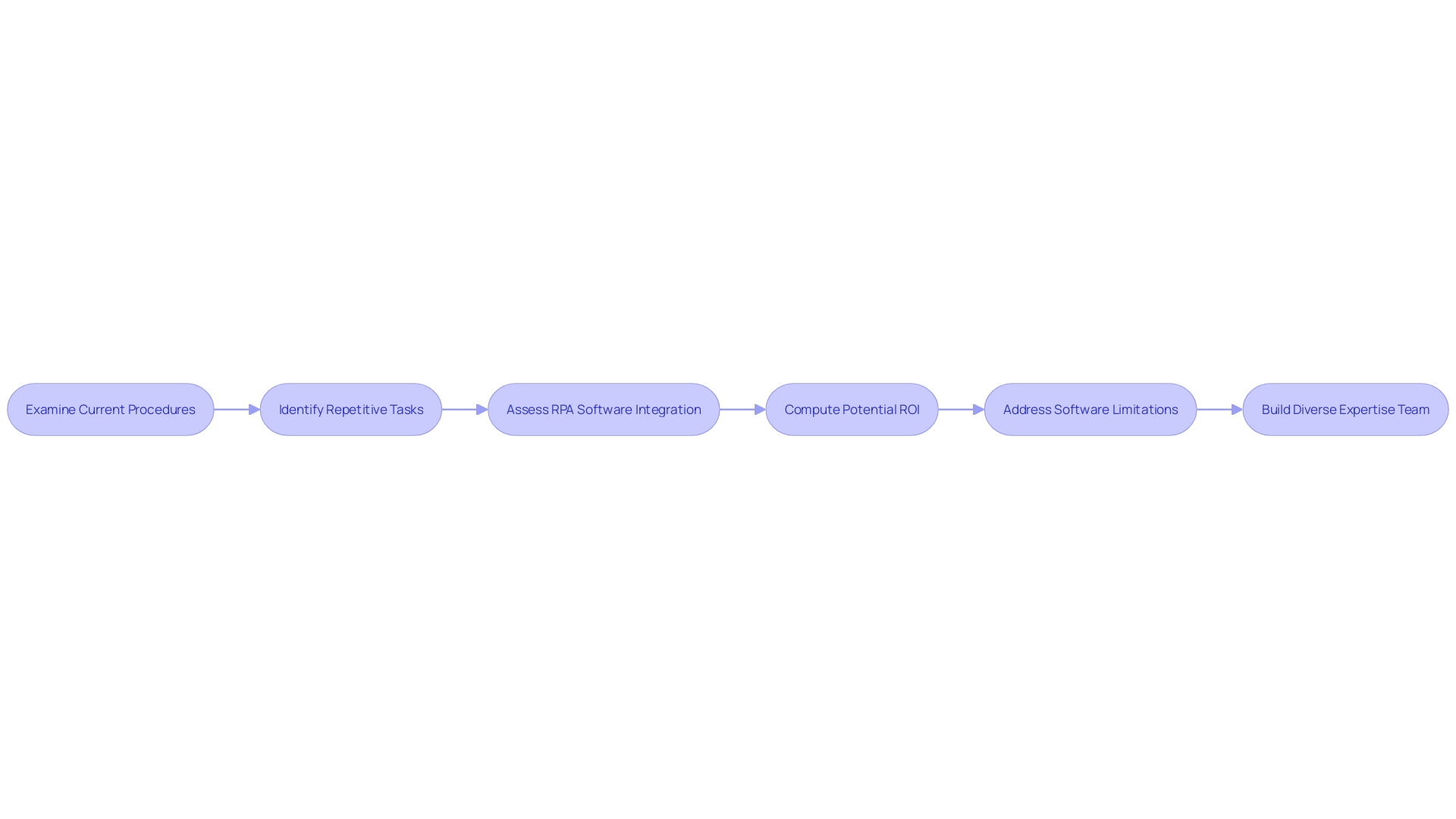
Applications and Use Cases of RPA
Robotic Process Automation (RPA) is revolutionizing the way businesses across various sectors operate by automating mundane, rule-based tasks. In the financial field, banks are utilizing RPA to accelerate activities such as customer onboarding, mortgage handling, and account reconciliation. This not only slashes processing times but also enhances accuracy, providing a seamless experience for both customers and employees. M&T Bank, a venerable institution with over 165 years of service, is a prime example of a bank embracing this digital transformation to maintain stringent security and compliance standards.
Healthcare is another sector reaping the benefits of RPA. With the ability to automate administrative tasks, including claims processing and appointment scheduling, healthcare providers can dedicate more attention to patient care. This shift is crucial in an industry where time and accuracy can significantly impact patient outcomes.
Taking a leap into supply chain management, RPA proves itself as a key player in automating inventory tracking, order processing, and shipment tracking. This process not only streamlines operations but also delivers real-time data, enabling more strategic decision-making. As stated by Adnovum and Squirro’s partnership, the integration of AI and RPA holds the potential to transform banking and insurance sectors profoundly.
Smart integration, combining RPA with AI, not only enhances procedures but also boosts effectiveness and well-informed decision-making. For organizations considering RPA adoption, it’s crucial to evaluate which manual processes are ready for mechanization, recognize inefficiencies that RPA can tackle, and compute the time and cost implications of integration.
According to Accenture’s analysis, early adopters of this technology could see substantial productivity improvements within the next three years. A significant portion of the time spent by US bank employees, around 73%, has the potential to be influenced by generative AI, with 39% being receptive to mechanization and 34% to enhancementâ suggesting a wide range of possibilities for operational improvement.
However, the path towards mechanization is not without its difficulties. Recent breaches in financial institutions, like the MoveIt software issue affecting 60 banks, underscore the importance of vigilant security measures in the adoption of new technologies. As organizations progress towards a digital future, collaborations with technology innovators like Coding Crafts are becoming more and more precious, providing cutting-edge solutions that go beyond mechanization and encompass blockchain development for enhanced security and transparency.
In conclusion, RPA’s role in driving operational efficiency is indisputable. As sectors keep maneuvering through the intricacies of digital transformation, the strategic deployment of RPA, supported by comprehensive examination and strong security measures, will play a crucial role in shaping the future of operational streamlining.
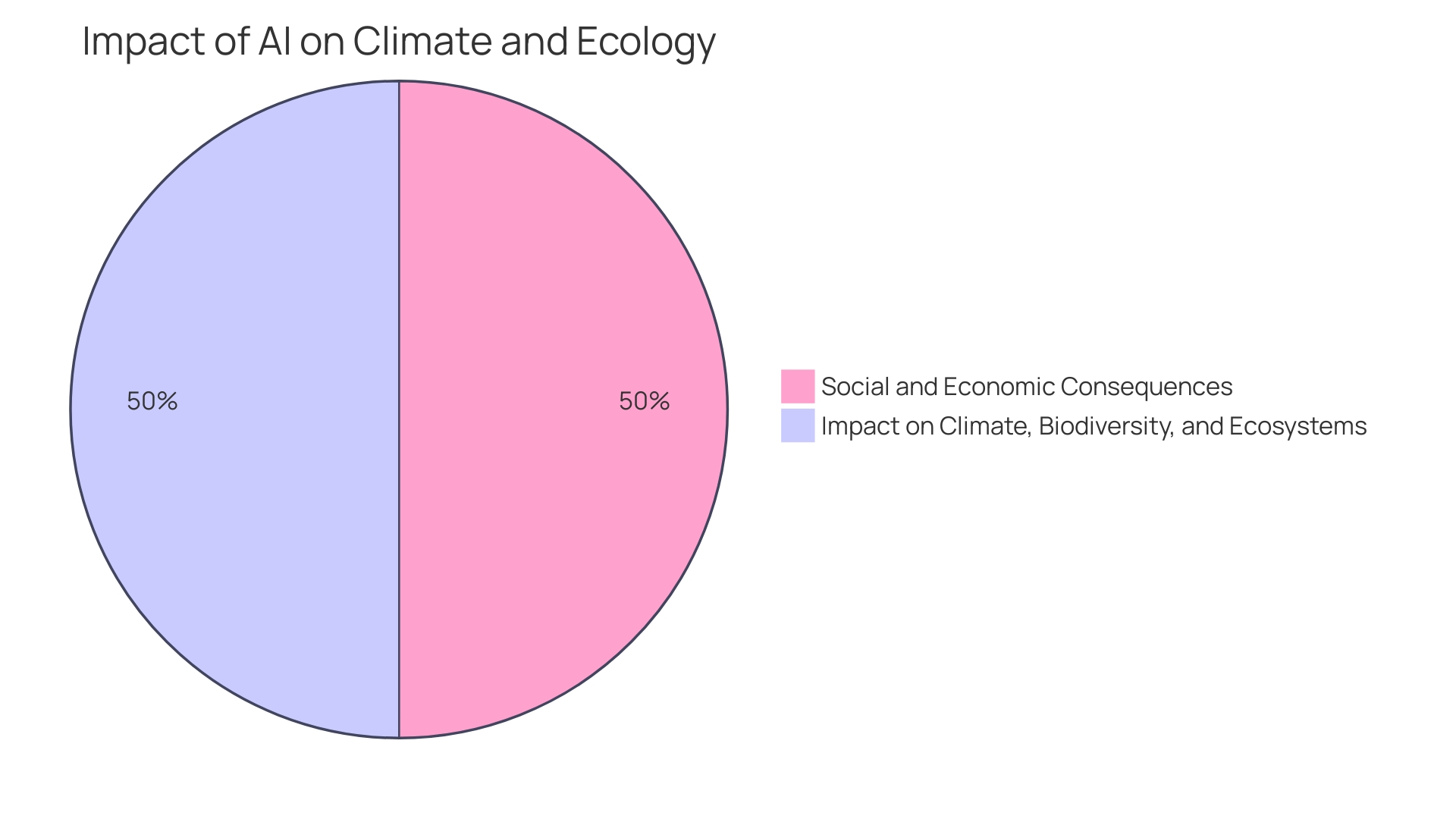
Benefits of Implementing RPA
Robotic Process Automation (RPA) holds the promise of revolutionizing business operations by automating routine tasks, enhancing accuracy, and ensuring compliance with regulatory standards. The key to achieving a successful implementation of RPA lies in the meticulous selection of manual processes to be automated, the analysis of the inefficiencies that can be addressed through automation, and the understanding of the integration costs and timeline.
Case studies provide real-world insights into RPA’s impact. For instance, M&T Bank, a trailblazer with over 165 years of experience, faced the digital transformation of the banking sector head-on. They set out to uphold stringent security and regulatory standards amidst the rapid adoption of new technologies, understanding that flawed software could lead to severe financial and reputational repercussions. Their approach focused on maintaining high-quality, compliant software to ensure seamless operations.
The financial sector is not alone in acknowledging the necessity for strategic mechanization. Across industries, companies are utilizing RPA to streamline operations and decrease manual labor costs, thereby reallocating resources more efficiently. For instance, a financial report emphasized a composite customer who, through investment in intelligent technology, witnessed revenue growth totaling 73% of the overall Net Present Value (NPV) benefit and a 5.4% Compound Annual Growth Rate (CAGR) over three years.
Implementing RPA is not without its challenges. It requires a strategic approach, starting with small, manageable tasks and gradually scaling to more complex workflows. Monitoring and documentation are crucial to assess the effectiveness and to learn from each project for future endeavors.
As leaders like Coding Crafts suggest, the journey towards effective RPA and Intelligent Automation (IA) is an ongoing process. It’s crucial to collaborate with innovative technology providers who provide comprehensive solutions extending beyond mechanization, such as blockchain development, to ensure security and transparency in digital transactions.
In sum, RPA offers a pathway to agility, allowing organizations to swiftly adapt to changing environments and scale operations effectively. By leveraging the potential of mechanization, businesses can concentrate on strategic initiatives, propelling growth and innovation.
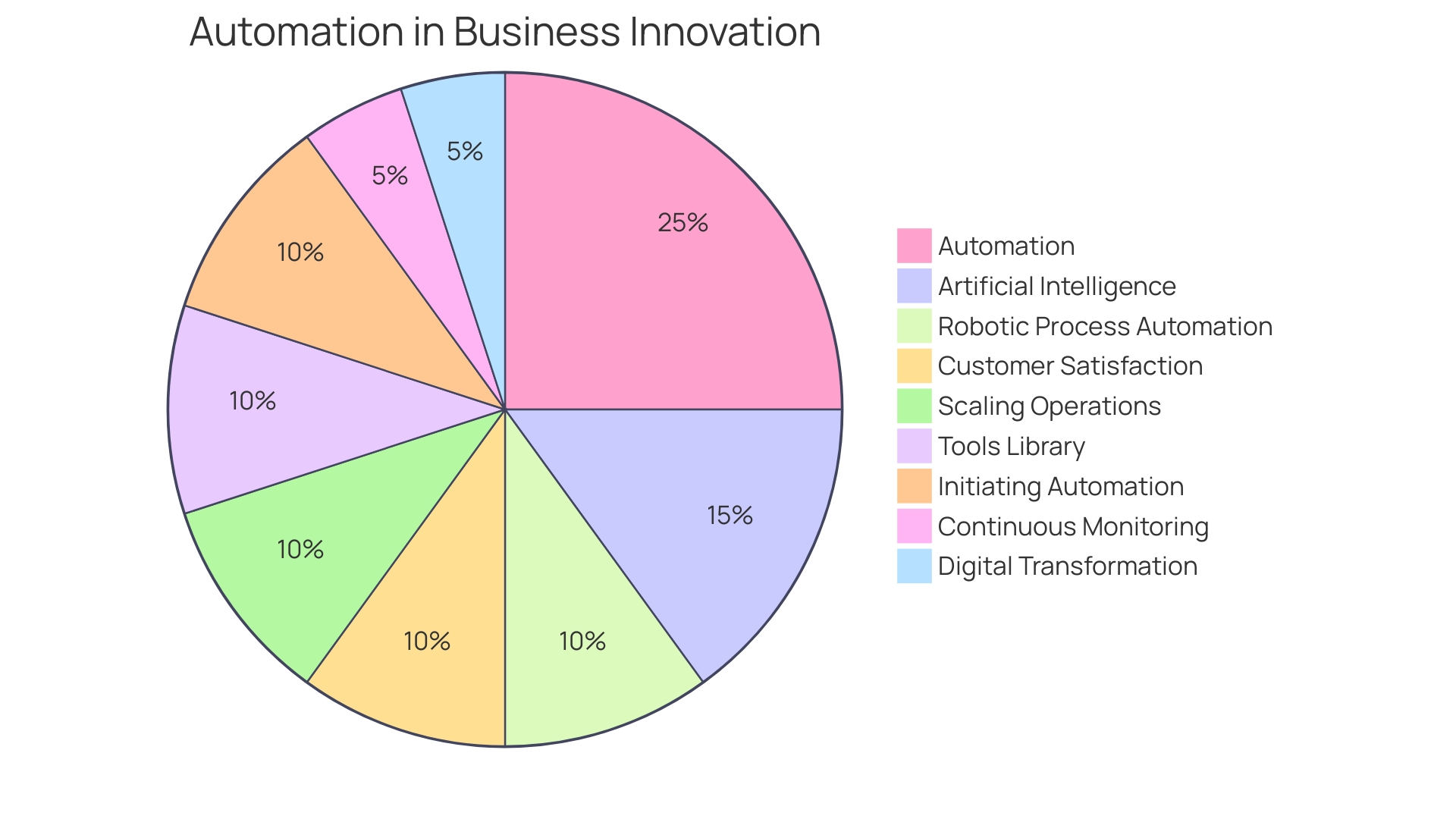
Comparison with Other Automation Technologies
Robotic Process Automation (RPA) is setting itself apart in the realm of mechanization by offering a user-friendly platform for automating rule-based tasks without the need for intricate coding or deep integration with underlying systems. Unlike traditional IT automation, which often requires specialized knowledge and can be resource-heavy, RPA bots are designed to be more independent. They can seamlessly interact with user interfaces, which streamlines the implementation, resulting in a faster and less resource-intensive deployment.
Adaptability is another characteristic of RPA, as these bots can be quickly configured and modified to fit changing business requirements, facilitating swift adjustments to procedures. While RPA inherently focuses on structured, rule-based tasks and lacks advanced cognitive functions, its true potential is unlocked when combined with AI and machine learning technologies. Such integration enhances the capabilities of RPA, enabling it to handle more intricate procedures that necessitate decision-making and learning abilities.
Comprehending the strategic implementation of RPA requires a comprehensive evaluation of current procedures. A careful approach should be taken, asking critical questions such as which manual processes are ready for mechanization, where the inefficiencies lie that can be remedied by RPA, and what the integration costs and timeframes look like. For instance, the NHS’s Digital Service Team exemplifies this approach by meticulously evaluating new technologies for security, appropriateness, and compliance before adoption.
Moreover, the adoption of RPA, particularly when fused with AI, is becoming a transformative factor for organizations aiming for digital transformation. As businesses navigate through the phases of identifying tasks suitable for mechanization, stakeholder engagement, and defining automation parameters including AI and RPA tools, they begin to craft more efficient, informed, and agile operational landscapes. The innovative approach is demonstrated by the establishment of tool libraries that support intelligent technology, with companies like SAP utilizing generative AI to expedite software development and enhance collaboration.
The path of mechanization, once confined to basic mechanical tasks, has progressed significantly. With every technological advancement, from the emergence of digital electronic computers to the latest in AI, the range of possibilities for mechanization continues to grow. This evolution has been a constant trend, shaping industries and the workforce alike. As we look to the future, small businesses, in particular, are finding value in RPA for enhancing customer satisfaction through faster and more accurate responses, thereby fostering stronger customer relationships and supporting scalable growth.
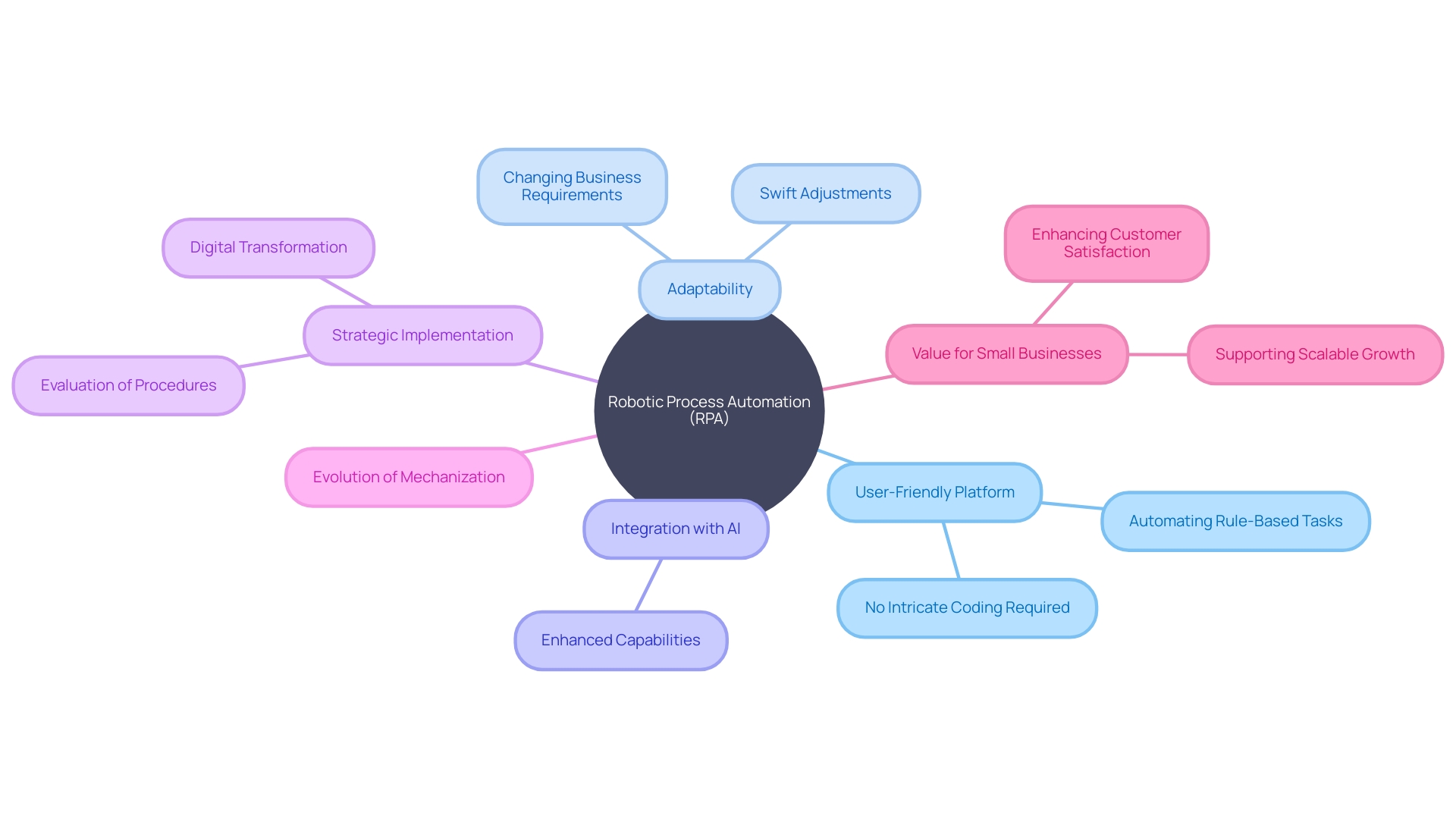
Integration with AI and Machine Learning
The fusion of Robotic Process Automation (RPA) with Artificial Intelligence (AI) and Machine Learning (ML) heralds a new chapter in automation that extends far beyond simple, routine tasks. By integrating AI, organizations can address intricate procedures that require a deeper comprehension, such as deciphering human languages, evaluating sentiments, and making nuanced decisions. This evolution allows organizations to process unstructured data, unearth profound insights, and make decisions rooted in data.
For instance, Lindy’s AI assistant exemplifies the seamless integration of a vast network of apps and services, showcasing the efficiency of AI in automating diverse tasks like medical scribing and customer support. Likewise, Adobe’s inventive use of AI in creating session summaries from transcripts showcases the time-saving potential of intelligent technology. Additionally, Delivery Hero’s use of RPA to address account lockout problems showcases the transformative effect of mechanization in enhancing operational efficiency, reducing the average recovery time significantly.
These advancements in RPA, AI, and ML are not limited to tech giants but are also available to small enterprises, allowing them to enhance customer relationships through faster response times and consistent information delivery. As companies strive to expand their operations effectively, beginning with small mechanization endeavors and progressively addressing more intricate workflows can result in significant enhancements. Continuous monitoring and documenting results are crucial for learning and future project enhancements.
Indeed, the technology landscape is advancing at a brisk pace, and embracing these cutting-edge tools is integral for companies to remain competitive and innovative. As Ranganathan Sundaram of TCS points out, the synergy of RPA and AI is a transformative factor for companies seeking digital transformation. The incorporation of these technologies opens the door for advanced automation and intelligent automation that can transform how enterprises operate and cater to their customers.
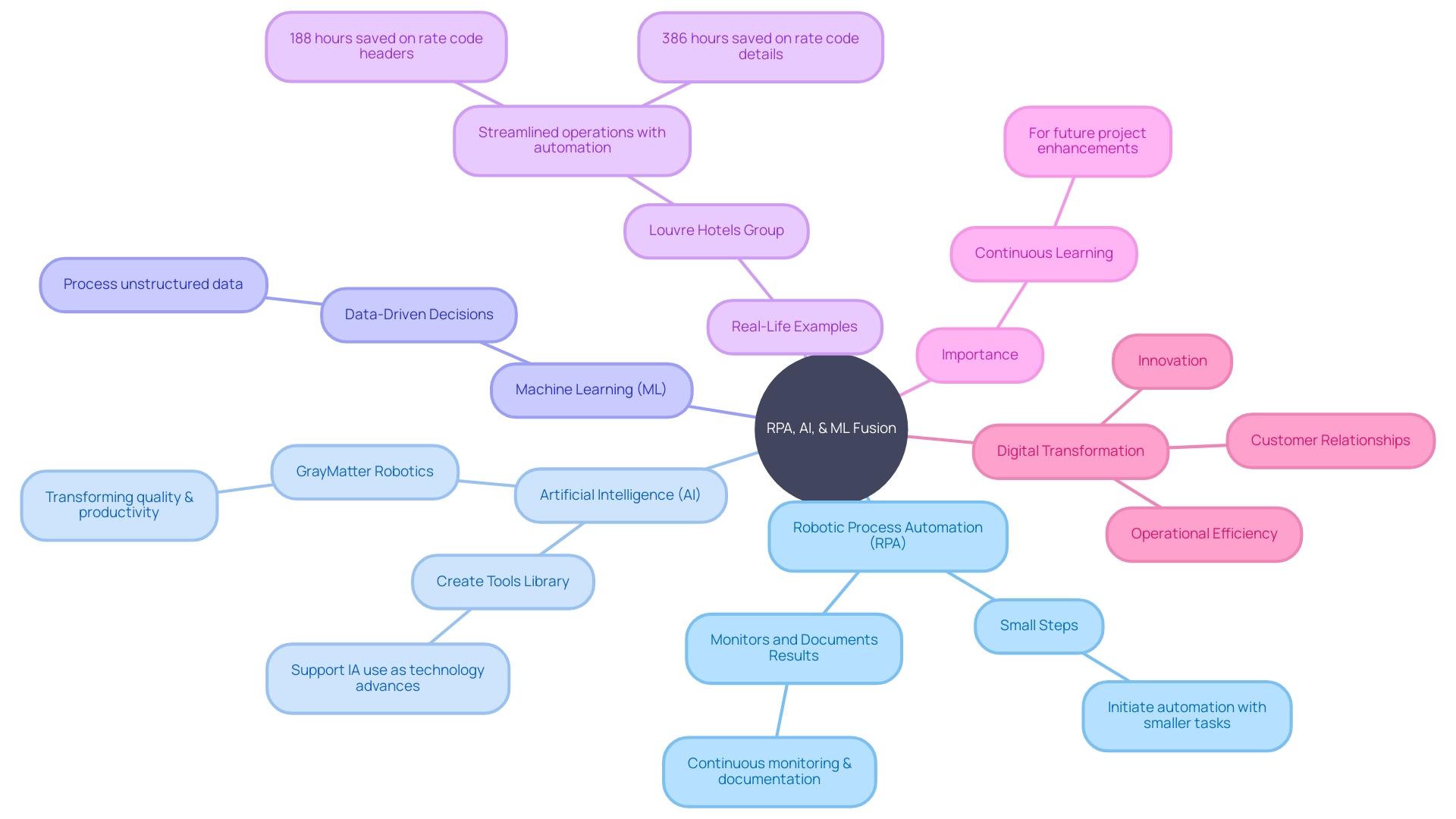
Implementation and Maintenance of RPA Solutions
Robotic Process Automation (RPA) is rapidly transforming the way businesses operate, providing a leap in productivity by automating routine tasks. However, the success of RPA integration is not simply about flipping a switch. It’s a well-orchestrated symphony of assessment, planning, and ongoing management. Take the Digital Service Team’s approach in the healthcare sector, for example. They meticulously assess whether new digital technologies align with existing systems and standards for security and compliance before implementation, echoing the precision required for successful RPA deployment.
Likewise, the partnership between Medien Hub Bremen-Nordwest and SC Soft shows that by selecting the appropriate AI platformâafter evaluating customer impact and operational efficienciesâthe outcomes can exceed expectations, transforming customer complaints into prompt resolutions. This reinforces the idea that RPA bots, once in place, need continuous monitoring to ensure they are meeting the set objectives.
Leaders must first identify which manual procedures are ready for automation, comprehend the specific inefficiencies to be addressed, and consider the time and cost implications. It’s not about automating for the sake of it, but about seeking tangible improvements in process management. As the noted AI expert Dr. Evan Shellshear posits, the application of AI tools across industries is about enhancing analytical solutions, from HR to supply chain management.
The importance of product thinking cannot be overstated. It requires a shift from a maintenance mindset to one of innovation, focusing on long-term growth and understanding user needs. As customer demands evolve, so too must the technology that serves them, backed by experience level agreements (XLAs) that measure the true impact on customer satisfaction.
Finally, it’s crucial to define clear timelines and success criteria, as suggested by industry best practices around AI governance. A strategic vision will guide the organization towards becoming an AI-enabled enterprise, a journey that, while ambitious, is increasingly necessary in today’s competitive corporate landscape.
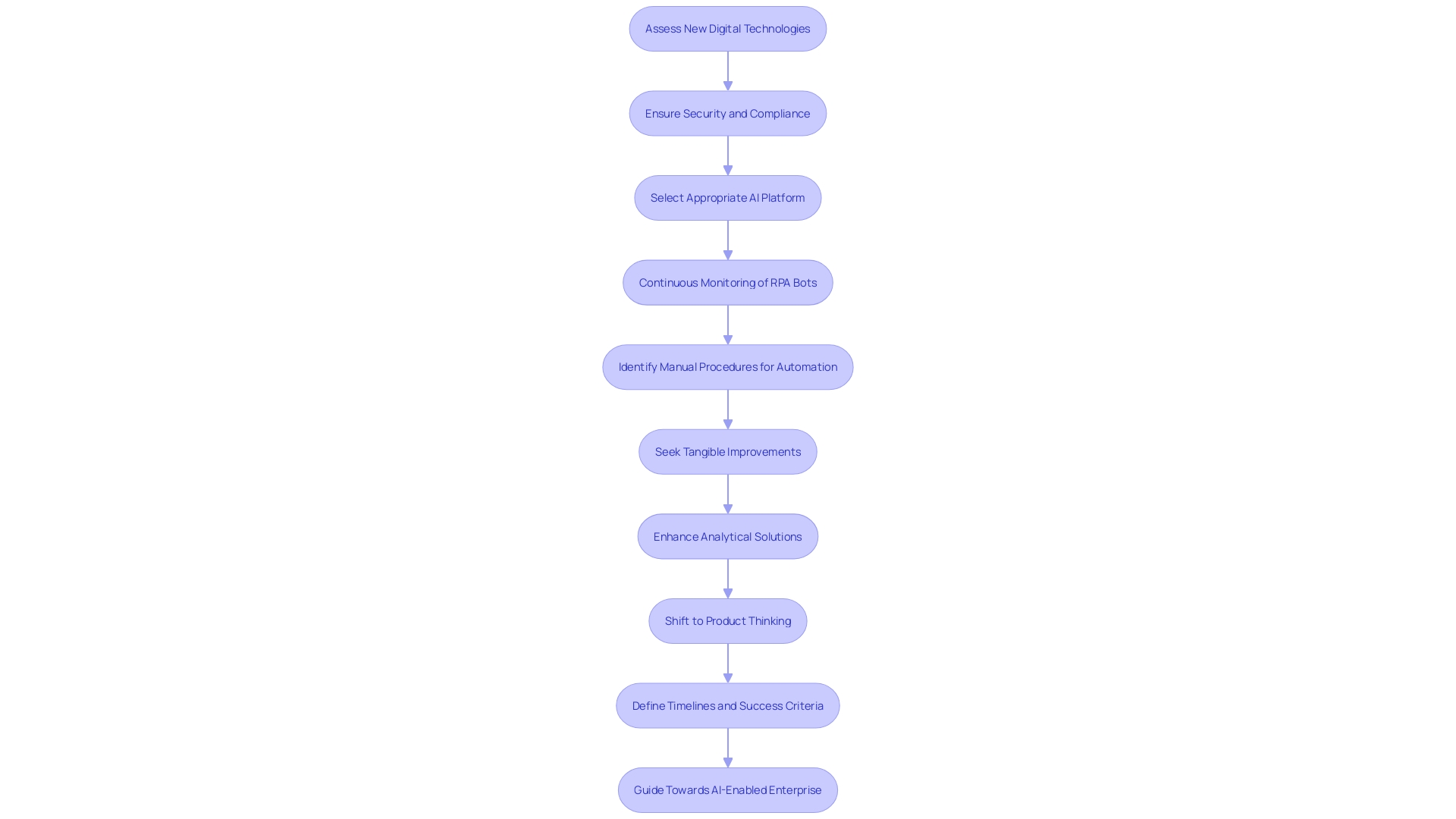
Role of RPA Business Analysts in Automation Projects
RPA Business Analysts are crucial in the realm of mechanization, serving as the linchpin that effectively aligns organizational requirements with technical solutions. Their role extends beyond mere analysis; they are the architects of mechanization strategies, engaging with stakeholders to pinpoint areas ripe for robotic intervention. With a keen eye on company objectives, they meticulously dissect existing workflows, sculpting the blueprint for automation that can revolutionize business operations.
Their collaboration with RPA developers is instrumental, ensuring that the architecture of automated solutions is perfectly attuned to the enterprise’s ambitions. This synergy is not static but a continuous dance of assessment and refinement, with RPA Business Analysts vigilantly overseeing the performance of RPA bots. Their insights are not just reports but catalysts for evolution, as they recommend enhancements that drive operations towards peak efficiency and effectiveness.
The transformative potential of RPA is vividly illustrated by Specsavers, which navigated a complex landscape to automate processes within its expansive global supply chain. Similarly, an educational department harnessed RPA to streamline student engagement tracking, showcasing the adaptability of RPA across varied sectors. These narratives underscore the versatility and impact of RPA when deftly managed by skilled Business Analysts.
Lately, the story of mechanization has been enhanced by advancements in AI, with enterprises utilizing these progressions to enhance efficiency and customer contentment. It’s a reminder that the process of mechanization is an ongoing one, marked by continuous monitoring and management to harvest its full potential. Automation Experts recommend starting small, focusing on tasks that are prone to error or time-intensive, and gradually scaling up to tackle more complex workflows.
Understanding the landscape of RPA and its applications is essential for Business Analysts, who must navigate an ever-expanding array of tools and approaches to optimize their craft. The distinctions between Analysts who specialize in bridging the gap between business imperatives and technological prowess, and Analysts who immerse themselves in the depths of data to uncover actionable insights, are also crucial.
This distinction is underpinned by the latest Global State of Business Analysis Report, which offers a tableau of trends and demographics shaping the field. The insights drawn from over 4,400 professionals indicate a shift in the age demographic of respondents, reflecting an evolving industry. It’s evidence of the ever-changing nature of the business analysis profession, and the vital role that RPA Business Analysts have in guiding organizations towards a future marked by efficient procedures and strategic mechanization.
Common Challenges and Best Practices
Embracing RPA technology requires a strategic approach to ensure its successful implementation. It starts with a thorough examination to determine which manual tasks are ready for mechanization and to grasp the particular inefficiencies that RPA can tackle. This pre-implementation stage is critical, as it sets the foundation for a seamless integration of RPA software, considering time and cost implications.
Once potential RPA opportunities are pinpointed, involving employees in the transition is paramount. It’s not just about introducing new technology; it’s about ushering in a cultural shift. Proper training and a support system are essential to foster acceptance and adaptability. Transparent communication about RPA’s role in enhancing job functions, rather than replacing them, reinforces its benefits.
The governance of RPA initiatives cannot be understated. A robust framework should be established that outlines clear roles, responsibilities, and benchmarks for success. Regular monitoring and evaluations allow organizations to stay on track, ensuring that RPA solutions deliver on their promise of increased efficiency and productivity.
In practice, the Digital Service Team of the NHS exemplifies a meticulous approach to adopting new technology, with an initial assessment that scrutinizes security, appropriateness, and compliance. Their digital-assurance process, involving detailed questionnaires to understand the needs and justification for technology requests, mirrors the careful planning necessary for RPA implementation.
Furthermore, it’s essential to recognize that automation, while a powerful driver of business innovation, is not a set-and-forget solution. It requires ongoing human oversight to manage, update, and optimize, as emphasized by industry experts. RPA is part of this lineage, aiming to augment human efforts, not replace them.
In conclusion, the journey to RPA is multifaceted, involving strategic planning, employee engagement, and diligent governance. By adopting these best practices, organizations can navigate the challenges and unlock the full potential of RPA, ensuring it becomes an integral and sustainable component of their operational fabric.
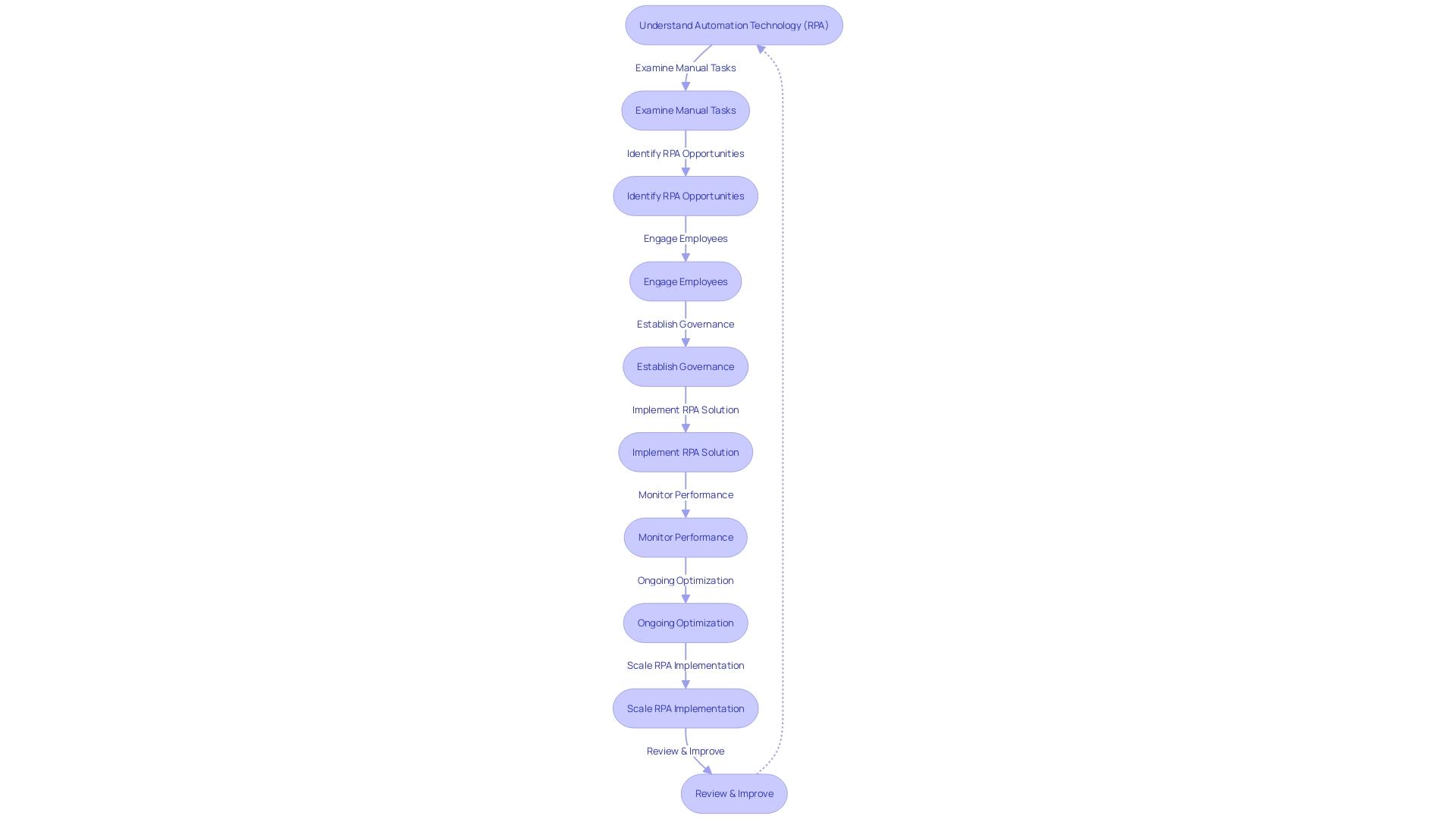
Conclusion
Robotic Process Automation (RPA) is revolutionizing business operations by automating tasks and streamlining processes. RPA simplifies complex tasks by deploying software robots that emulate human interactions with applications and systems. It enhances operational efficiency by handling routine tasks, allowing human creativity to flourish.
The integration of RPA with AI offers practical solutions for better decision-making and scalability.
RPA finds applications in various industries, from finance to healthcare and supply chain management. It expedites processes, enhances accuracy, and enables real-time data-driven decision-making. RPA Business Analysts play a crucial role in aligning business needs with technical solutions, ensuring the successful implementation of automation projects.
Implementing RPA requires a strategic approach, starting small and scaling up gradually. Continuous monitoring and documentation are essential for assessing effectiveness and guiding future projects. Employee involvement, transparent communication, and a robust governance framework are key to seamless integration and ongoing management of RPA solutions.
In conclusion, RPA drives operational efficiency and enhances collaboration between humans and digital labor. Integration with AI offers practical solutions for better decision-making and scalability. With careful planning, employee engagement, and diligent governance, organizations can successfully leverage RPA’s potential and unlock enhanced business automation.

